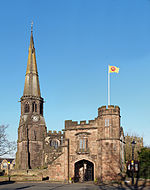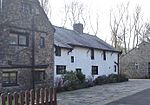St Wilfrid's Church, Standish
16th-century Church of England church buildingsAustin and Paley buildingsBuildings and structures in the Metropolitan Borough of WiganChurch of England church buildings in Greater ManchesterChurches completed in 1584 ... and 8 more
Diocese of BlackburnEnglish Gothic architecture in Greater ManchesterEngvarB from September 2013Grade I listed churches in Greater ManchesterMajor Churches NetworkRenaissance architecture in EnglandSource attributionStandish, Greater Manchester

The Church of St Wilfrid is in Market Place, Standish, Wigan, Greater Manchester, England. It is an active Anglican parish church in the Diocese of Blackburn. It is recorded in the National Heritage List for England as a designated Grade I listed building. The authors of the Buildings of England series describe it as "one of the most interesting churches in Lancashire".
Excerpt from the Wikipedia article St Wilfrid's Church, Standish (License: CC BY-SA 3.0, Authors, Images).St Wilfrid's Church, Standish
Rectory Lane,
Geographical coordinates (GPS) Address External links Nearby Places Show on map
Geographical coordinates (GPS)
| Latitude | Longitude |
|---|---|
| N 53.5872 ° | E -2.6614 ° |
Address
Saint Wilfrid's
Rectory Lane
WN6 0XA
England, United Kingdom
Open on Google Maps








